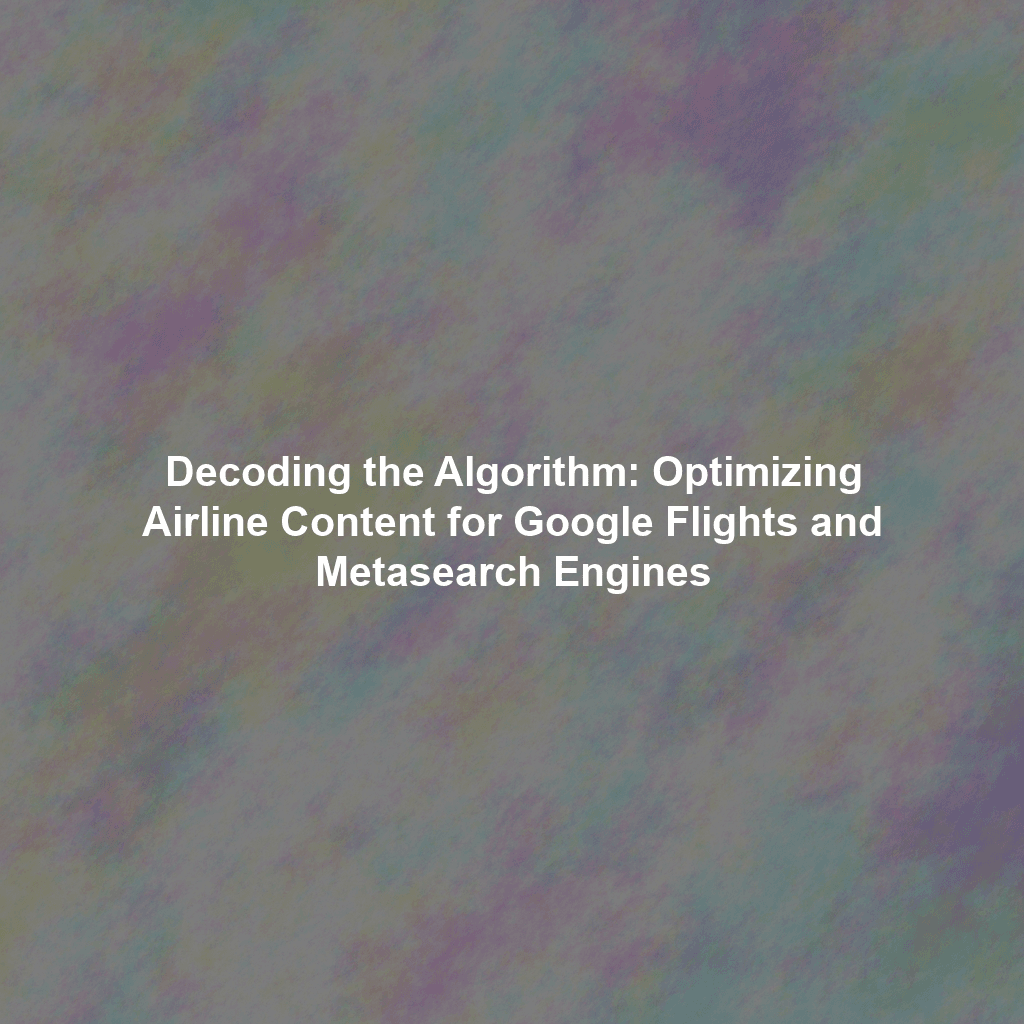In the fiercely competitive airline industry, securing top placement on Google Flights and other metasearch engines is no longer a luxury – it’s a necessity. These platforms are often the first port of call for travelers seeking the best deals, making visibility crucial for driving bookings and boosting revenue. But how exactly do these complex algorithms work? This article delves into the technical and content-driven strategies that can elevate your airline’s presence and ensure your flights are seen by the right customers.
Understanding the Metasearch Engine Landscape
Google Flights is the dominant player, but other metasearch engines like Kayak, Skyscanner, and Momondo also wield significant influence. Each platform has its own proprietary algorithm, but they all share core principles: providing users with accurate, up-to-date information and a seamless booking experience. Optimizing for these platforms requires a multi-faceted approach, blending technical SEO with compelling content and a superior user experience.
The Importance of Accurate Data
At the heart of any metasearch engine ranking lies accurate and readily available data. If your flight information is incomplete, outdated, or inconsistent, you’ll quickly be penalized. This underscores the importance of a robust and reliable data feed.
Technical SEO: Laying the Foundation
Technical SEO ensures that metasearch engines can easily crawl, understand, and index your flight data. Several key elements contribute to this:
Structured Data Markup: Schema.org for Flights
Implementing structured data markup using Schema.org vocabulary is paramount. This allows search engines to understand the context of your flight information, including origin, destination, dates, times, prices, and availability. Using the Flight schema type provides crucial context to search engine crawlers. For example:
<script type="application/ld+json">
{
"@context": "https://schema.org",
"@type": "Flight",
"departureAirport": {
"@type": "Airport",
"iataCode": "JFK"
},
"arrivalAirport": {
"@type": "Airport",
"iataCode": "LAX"
},
"departureTime": "2024-01-20T08:00:00-05:00",
"arrivalTime": "2024-01-20T11:00:00-08:00",
"flightNumber": "AA123",
"offers": {
"@type": "Offer",
"price": "350",
"priceCurrency": "USD",
"availability": "InStock",
"url": "https://www.example.com/flight/jfk-lax"
}
}
</script>
Pricing and Availability Feeds
Metasearch engines rely on real-time pricing and availability feeds to display accurate information to users. These feeds are typically in formats like IATA’s NDC (New Distribution Capability) or legacy formats like ATPCO. Maintaining a consistent and accurate feed is crucial. Regular updates and robust error handling are vital to avoid displaying incorrect information, which can lead to ranking penalties and lost bookings.
Website Speed and Performance
Page load speed is a critical ranking factor for all search engines, including Google Flights. Slow-loading pages frustrate users and can lead to lower conversion rates. Optimize your website for speed by:
- Minimizing HTTP requests
- Compressing images
- Leveraging browser caching
- Using a Content Delivery Network (CDN)
- Optimizing your code
Content Strategies: Elevating Your Ranking
While technical SEO provides the foundation, compelling content and a superior user experience are essential for boosting your ranking and attracting customers.
Landing Page Experience
When a user clicks on your flight listing, the landing page should provide a seamless and relevant experience. The information displayed on the landing page should match the details presented in the metasearch results, including price, dates, and flight times. Avoid discrepancies, as they can erode trust and lead to users abandoning their booking. Clear call-to-actions and a streamlined booking process are also essential.
Unique Value Proposition
In a crowded marketplace, it’s essential to differentiate your airline. Highlight your unique value proposition, such as:
- Superior in-flight entertainment
- Complimentary meals
- Generous baggage allowance
- Flexible booking policies
Showcase these benefits prominently on your website and landing pages to attract customers and justify your pricing.
Mobile Optimization
With the majority of travelers using mobile devices to search for flights, mobile optimization is non-negotiable. Ensure your website is fully responsive and provides a seamless experience on all devices. Mobile-first indexing means that Google primarily uses the mobile version of your site for indexing and ranking.
Customer Reviews and Ratings
Positive customer reviews and ratings can significantly influence your ranking and booking conversions. Encourage satisfied customers to leave reviews on platforms like Google Reviews and TripAdvisor. Actively monitor and respond to reviews, addressing any negative feedback promptly and professionally.
Monitoring and Iteration
Optimizing for metasearch engines is an ongoing process. Continuously monitor your ranking, website performance, and user behavior. Use analytics tools to identify areas for improvement and adjust your strategies accordingly. A/B testing different landing page layouts, offers, and content can help you identify what resonates best with your target audience.
Conclusion: Soaring to New Heights with Strategic Optimization
Mastering the art of optimizing airline content for Google Flights and other metasearch engines requires a deep understanding of both technical SEO and content strategy. By focusing on accurate data, structured data markup, website speed, compelling content, and a superior user experience, you can significantly improve your visibility, attract more bookings, and ultimately achieve greater success in the competitive airline industry. Embrace a data-driven approach, continuously monitor your performance, and adapt your strategies to stay ahead of the curve. With dedication and strategic optimization, your airline can soar to new heights in the digital landscape.
 Skip to content
Skip to content
